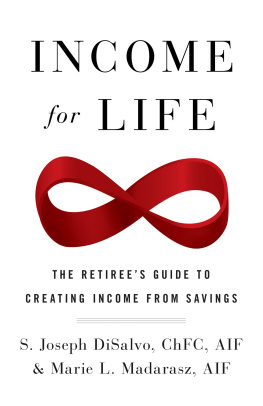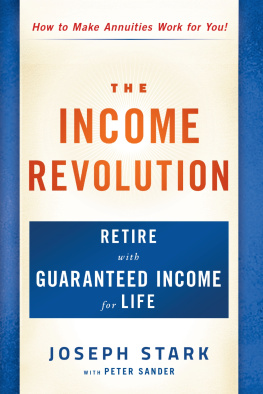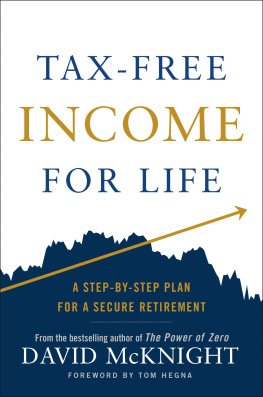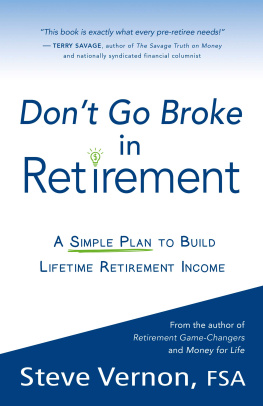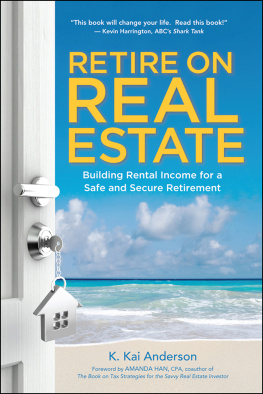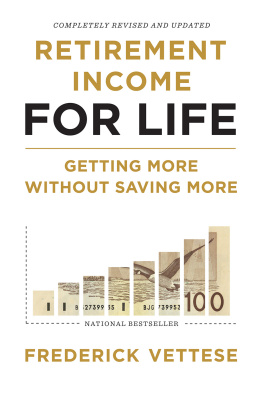Copyright 2019 S. Joseph DiSalvo & Marie L. Madarasz
All rights reserved.
To our clientswhose wisdom, visions of the future, and commitment to following a plan continues to inspire and motivate us to keep learning and improving.
Introduction
Between the years of 1946 and 1964, seventy - six million babies were born in the United States; today, the baby boomer generation represents nearly a quarter of the American population. At this moment, these seventy - six million Americans are on the verge of retirementand some have already passed that threshold. Americans are now retiring earlier than any other time in history, with the average retirement age currently sitting at sixty - three , and millions opting to retire even earlier, in their late fifties. Concurrently, Americans are now living longer than they ever have before.
The confluence of these sociological shifts has created a landscape of uncharted territory for those about to retire. What income, precisely, can be expected or counted upon? What kind of preparation and planning will be required? Exactly how much money will one need for a retirement that lasts thirty or forty years, rather than ten or twenty?
If youre among those feeling uncertainty about your financial future as you move into retirement, you are the person for whom we wrote this book.
Its natural, and even reasonable, to have myriad questions about how to prepare for retirement. Are you financially prepared for this transition? How much will you be able to spend each year? What will happen when the stock market takes an inevitable future downturn? Will you be able to maintain your current standard of living? The baby boomers, after all, are the healthiest, most active aging demographic the country has ever seen. In contrast to earlier generations, baby boomers have more money and are accustomed to spending more money. They are also known broadly as the sandwich generation; many baby boomers simultaneously care for both their elderly parents and their cash - strapped children.
This creates a somewhat scattered puzzle to assemble as retirement approaches. Many of our clients come to us with a host of questions that reveal a lack of confidence in their ability to maintain the strong self - reliance ingrained into them by their Depression - raised , WWII - forged parents. Deep knowledge of personal financial planning is uncommon among the general population. Personal financial education is essentially nonexistent; there are few personal finance courses offered in high school or college, even though a basic foundation of knowledge in that discipline is possibly the most important thing we can teach our children to ensure that they will not just survive as adults, but thrive.
Without that basic foundation, its no wonder that many retirement - age Americans feel deeply unsettled, and even afraid, of what comes next. And without the context of financial literacy, its nearly impossible to make decisions in the face of shifting social security and Medicare policy, and the de - prioritization of pensions in favor of what is referred to as a Defined Contribution Plan, i.e., 401(k), 403(b) etc. The retirement landscape that baby boomers must prepare to navigate is simply not the same world their parents lived in. Some anxiety is to be expected.
Thats why we wrote this book. This fear can be mostly overcome with a straightforward education of the basics and practical tools to help you plan for the road ahead. Throughout our careers, which span a combined forty years, weve helped hundreds of clients (and thousands of others through our workshops) like yourself build confidence and security in their upcoming retirement; were eager now to share this wealth of knowledge with you, and help you envision your future as one not of uncertainty, but of opportunity, and even abundance.
Plan for Your Future
Where should you begin your retirement planning? With so many elements of socioeconomic change at play, so many pieces of the puzzle to sort and organize, and so much at stake, what starting point makes the most sense?
Unlike previous generations, who were able to rely on the primary safety nets of social security benefits and pensions when defining and mapping their post - retirement income and spending, baby boomers are best served by learning the fundamentals of investing and the fundamentals of converting their savings to an ongoing, growing income stream. This is not to diminish the potential impact of a good social security decision. Planned well, a good social security claiming decision will easily represent tens or hundreds of thousands of dollars of additional income in retirement. However, social security planning deals with a static source; once youve made your decision and executed that part of your plan, for the most part, its done.
By contrast, your investments, and how you go about converting those investments into income, represents an ongoing opportunity to a continuously growing income stream; as such, a solid and well - planned investment and income strategy is where youll create the greatest impact on your retirement. Its been our experience that most people lack confidence when it comes to investing. Some may consider themselves unlucky in the market (when, in reality, theyve probably just been receiving the wrong advice), or others may write themselves off entirely, chalking up their lack of investment knowledge to the idea that investing is a specialized skill they never learned and will probably never understand.
Even those who made good investments over the course of their working years with an eye toward retirement may feel burned by the recent market events in 2008 and the resulting recession. They may have lost a sizeable portion of their safety net, and along with it, their confidence.
Our goal with this book is to rebuild or create from scratch that confidence so that you can feel safe, not fearful, as your retirement approaches. Well give you the tools to make informed choices, and well deliver the clarity youre seeking in the form of accessible, practical exercises that will build your skills in retirement income planning.
By the time youve finished reading this book, youll have a clear idea of how to organize your finances and how to develop an impactful investment and income strategy. Well answer the most common questions weve heard about retirement planning, which are probably most of the questions youve accumulated, as well. Youll learn how to focus on what you can control versus what you cantand youll learn how to distinguish between the two. Youll be far better prepared to know what further questions to ask if you choose to work with whomever you choose to work with, whether they be a discount broker, a full - service broker, or a true financial advisorand youll gain insight into how those roles differ, and what kind of advice you should seek.
Put simply, youll come out the other side of this book exponentially better - informed , better - prepared , and our hope is far more confident. Most importantly, youll be in a strong position to make informed choices that will have a positive impact on your future.
Mastering the Fundamentals
We constructed this book to be a straightforward, accessible education in how to invest your savings to create a growing stream of income in retirement. Our aim is to help you get organized and provide you with a strong foundation for creating your retirement income strategy.

